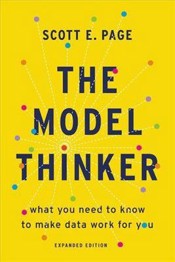The Model Thinker: What You Need to Know to Make Data Work for You

This is literally a textbook – the author says much at the beginning. He’s a professor at the University of Michigan, and he writes about how a friend asked him to resurrect a course on statistical modeling. That course became this book.
Models are ways of thinking and analyzing a subject. It’s a way of abstracting a complex topic to simpler subjects and even straightforward math. And there’s a lot of complex words, thinking, and math in here to describe things you already know intuitively.
For example, popular things tend to stay popular. Since they’re popular, people talk about them, so people know about them, so people pick them over things they don’t know about. This fits into a category called “path dependence” and manifests as several different models like Polya and Bernoulli.
I mention that just as one example – there’s about two dozen chapters like that.
What this means is that the book is dense. It’s as well-written as it can possibly be, and as clear as it can possibly be – but it’s still a lot.
This is one of those books where you’d have to do one of two things, and probably both:
- Read it in a group and discuss each chapter
- Apply to it to actual real-world problems as a learning tool
At the end of the book, the author does just that: he applies models to the Opioid epidemic, COVID-19, and income inequality. What I found was most helpful was this – I could figure out what models mattered.
To be clear, there are a lot of models described in this book. And clearly, some are more important than others. But you don’t know which is which from the main part of the text. The real-world application helps.
I never know what to do with these kinds of books. They’re wildly important, and the information is valuable, but without one of the two options above, it’s just tough to absorb.
I got about three-quarters of the way through this, and realized a lot of it was going over my head. So I skipped to the conclusion where he talks about real-world application, then went back and read some of the models he mentions during that section.
(In particular, the Multi-Armed Bandit is critical in my industry. I learned a lot there, which I’ll write about in the future.)
Book Info
- I have read this book. According to my records, I completed it on .
- A softcover copy of this book is currently in my home library.